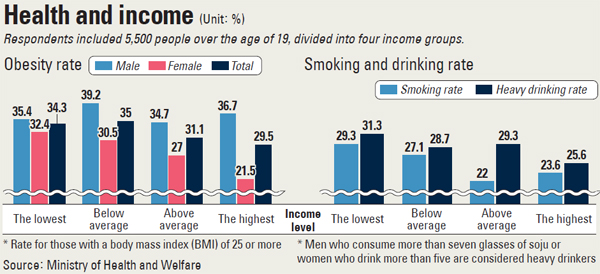Income divide reflected in health, obesity stats

The Ministry of Health and Welfare surveyed 5,500 people over the age of 19 about exercise, obesity, drinking and smoking, and divided their answers into four income groups: highest, above average, below average and lowest.
For example, the obesity rate was much higher for the lowest-income group than the highest. For the highest-income group, 29.5 percent reported being obese (having a body mass index of 25 or more), while 34.3 percent of the lowest-income group was obese.
The disparity was even more noticeable among women, with 21.5 percent of those in the highest-income group reporting being obese compared to 32.4 percent of the lowest bracket.
A similar difference could be seen in the amount of exercise the income groups did. Those in the lowest bracket did the least amount of exercise, with only 14.4 percent reporting doing moderate to intense physical activity for more than 10 minutes at least once a week.
For lower-than-average incomes, 16.4 percent reported exercising at least once a week, while 17.3 percent of above-average incomes did so and 21.5 percent of the highest-income group.
Although the lowest-income group worked out less, they smoked and drank more than the rich. While 39.4 percent of the highest group said they smoked regularly, 43.9 percent of the lowest group did. When asked if they drink more than seven glasses of soju (the popular Korean liquor) or five cans of beer at least once a week, 31.3 percent of the lowest-income group said they did compared to 25.6 percent of the highest group.
Among the lowest-income group, 5.9 percent said they had not gone to the hospital despite being sick at least once in the last year because of financial reasons. Only 0.9 percent of the highest-income group reported the same.
Another report about medical expenditures released yesterday by the National Health Insurance Service said only 62.5 percent of medical expenses were covered by health insurance in 2012, leaving patients to pay the other 37.5 percent.
The coverage has decreased for three consecutive years, falling from 65 percent in 2009.
BY JANG JOO-YOUNG [bongmoon@joongang.co.kr]










with the Korea JoongAng Daily
To write comments, please log in to one of the accounts.
Standards Board Policy (0/250자)